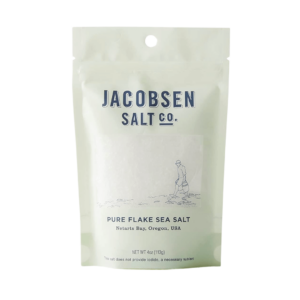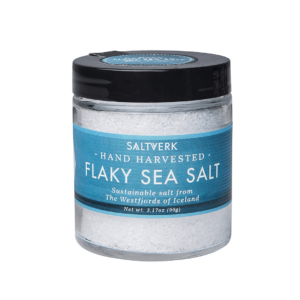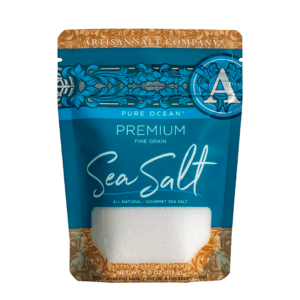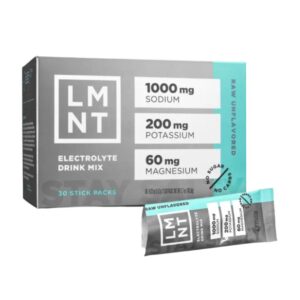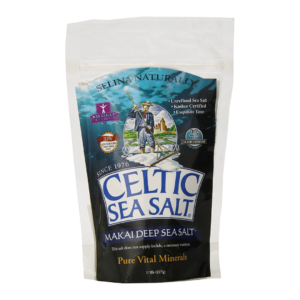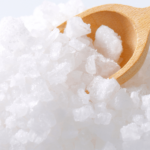Are you feeling salty about not being able to enjoy your favorite foods because of health concerns? Well, fear not my seasoned foodie friends, because today we are diving into the world of the healthiest salt brands! Table salt, sea salt, Himalayan salt galore – what’s the best choice? Do minerals in salt matter? Are there heavy metals or microplastics in salt? Is salt actually bad for you?
Not all salt is created equal! So, let’s shake things up and explore the best salt brands to add a little spice to your life!
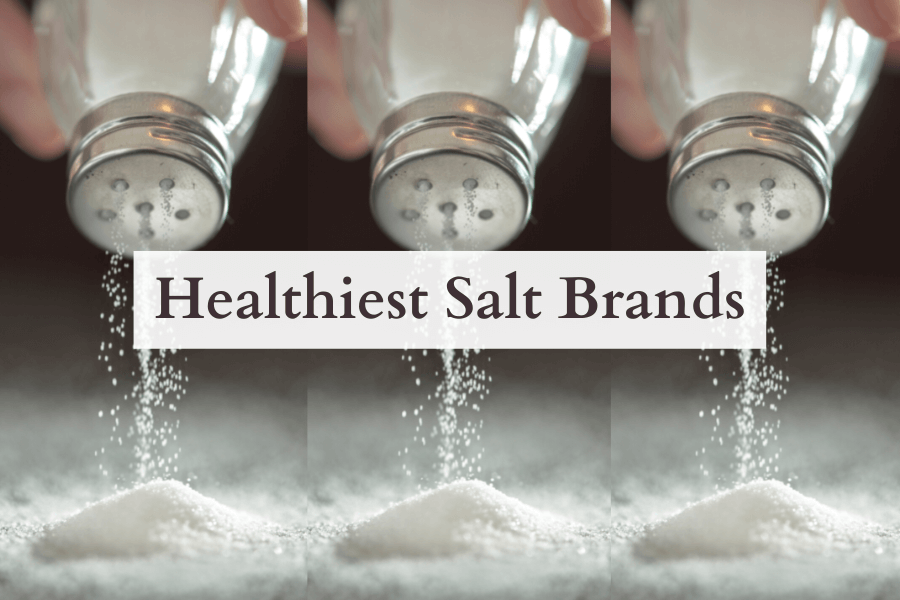
Note: This article contains affiliate links, meaning In On Around will make a small commission at no additional cost to you. This helps me maintain the site. As always, I value full transparency & only work with brands I love and trust.
What Is Salt? Minerals In Salt Explained
Salt gets a really bad rap. It’s a naturally occurring mineral compound composed mainly of sodium chloride (NaCl). It is an essential nutrient for human health and is involved in various bodily functions, such as regulating fluid balance, transmitting nerve impulses, and helping muscles contract and relax.
Salt can be found in many forms, including table salt, sea salt, and rock salt. It is commonly used as a seasoning and preservative in food, as well as in various industrial applications. Despite its importance, excessive salt intake has been thought to have negative health effects (we’ll dive into the low-sodium craze more below).
Salt doesn’t deserve the bad rap!
Salt typically contains minerals such as sodium, chloride, magnesium, iron, zinc, and potassium. Minerals are essential nutrients that the body needs in order to function properly, and they cannot be synthesized by the body, so they must be obtained through diet or supplements. Without minerals, the body would be unable to carry out many critical functions, which could lead to a range of health issues and complications.
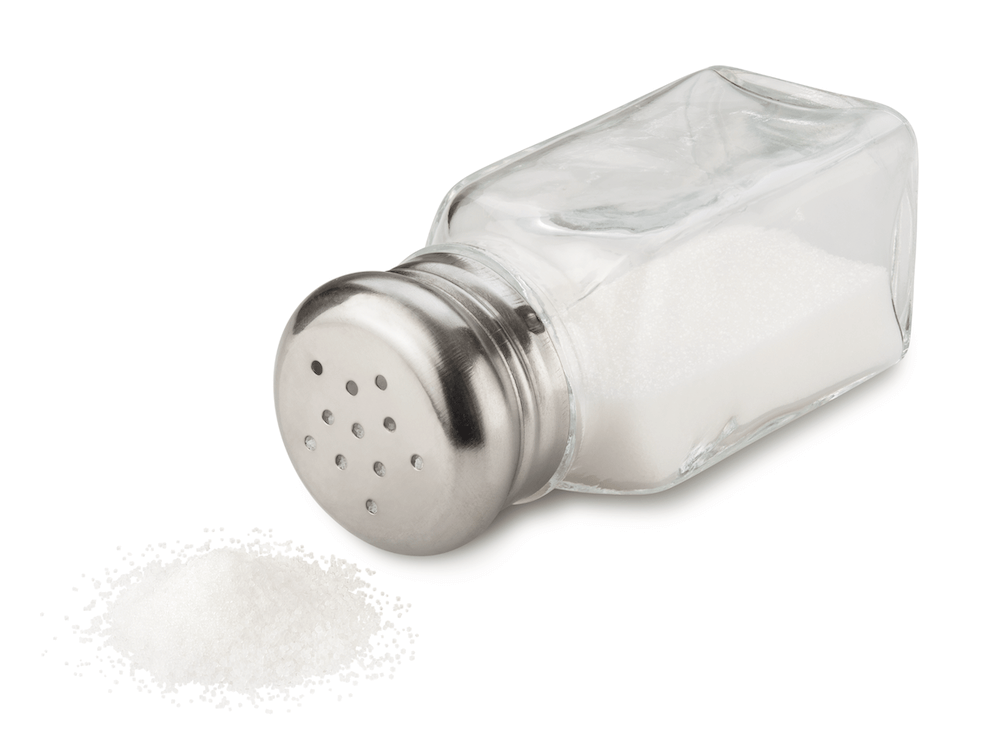
Did You Know…?
Did you know that most salt intake comes from processed foods?
Over 70% of the sodium we consume comes from packaged, prepared and restaurant foods! [1]
The top 10 sources of sodium in food are: [2]
- Breads
- Pizza
- Sandwiches
- Cold cuts, luncheon and cured meats – you can learn more about this here
- Soups
- Burritos/Tacos
- Snacks, like chips, crackers, pretzels, etc…
- Poultry/Chicken
- Cheese
- Egg dishes or omelets
Keep this in mind the next time you buy packaged foods or eat out.
How Salt Is Extracted
This previous mineral can be extracted in a couple of different ways, like through:
- Salt mines
- Salt pans
- Seawater
Let’s explain each method…
1 – Salt Mines
For salt mines, the salt is first drilled and blasted from the earth’s surface or underground. The salt is then crushed into smaller pieces and transported to a processing plant. At the plant, the salt is cleaned and refined, typically through washing, filtration, and evaporation methods, until it reaches the desired purity level.
Typically, this method can require a lot of energy and water, which isn’t the most eco-friendly.
We cannot live without salt!
2 – Salt Pans
Salt pans, also known as salt evaporation ponds, use the power of the sun (solar evaporation) to evaporate seawater or groundwater. This process leaves behind salt crystals which are then harvested. The water is first channeled into shallow pools and left to evaporate naturally over several months (it’s certainly a longer manufacturing process). The resulting salt crystals are then harvested and cleaned using mechanical equipment.
This is typically the most eco-friendly way to extract salt. It does not require the use of fossil fuels or electricity and has a low carbon footprint.
3 – Seawater Extraction
Seawater is also a common source of salt (no surprise there). In this case, the seawater is first pumped into large evaporation ponds or tanks. The water is then heated until most of it evaporates, leaving behind salt crystals. The salt is then harvested and cleaned using various methods, such as centrifugation or washing.
Regardless of the source, the extracted salt must be further processed in some way to remove impurities before it can be sold for consumption. This is generally more environmentally friendly than salt mining.
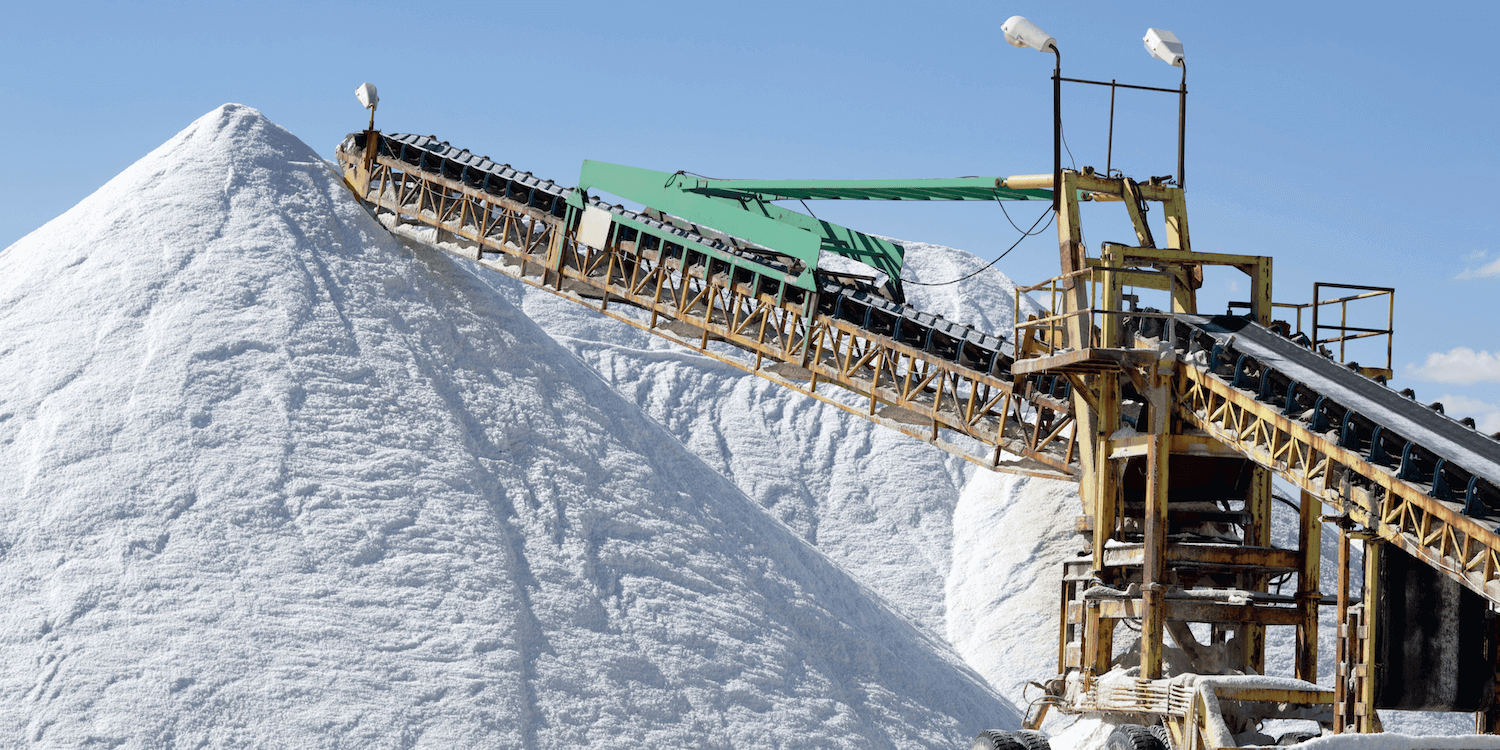
Is Salt Good For You?
Yes, salt can be very good for you, since it helps to serve essential bodily functions. Salt can help to… [3, 4, 5, 6]
- Regulate fluid balance
- Support nerve function
- Assist in digestion
- Regulate sleep
- Maintain blood pressure
- Promote brain health
- Support respiratory health
- Increase energy
- Support libido
- Promote vascular health
- Maintain electrolyte balance
- Increase bone strength
- Promotes nutrient absorption
- Enhance flavor
… and much more.
How salt impacts your body can also depend on any specific conditions or diseases you may have. For instance, high sodium chloride levels have been potentially associated with pro-inflammatory pathogenesis in autoimmune and neurodegenerative diseases, such as multiple sclerosis. [7] As always, talk to your naturopathic physician!
Keep in mind, too much of anything can be a bad thing. This is why it’s essential to prioritize whole, unprocessed foods into your diet! Read nutrition labels carefully.
Too much of a good thing can be a bad thing. Salt is no exception.
Is A Low-Salt Diet Healthy?
It really depends on your specific dietary needs, but a low-salt diet isn’t always healthy.
In fact, a 2014 study said that both low and high-salt diets are associated with increased mortality. [8] Low-salt diets can also potentially trigger insulin resistance in healthy people. [9, 10, 11] This means that low-salt diets can actually increase your risk of obesity by raising insulin, which encourages fat storage.
In addition, a 2016 study showed that low-salt diets and salt restriction can have a detrimental impact on heart failure patients. [12] In animal models, a low-salt diet has been shown to actually accelerate atherosclerosis. [13] It’s also essential to have the proper balance between sodium and potassium.
Clearly, while too much sodium can be harmful, so can too little sodium.
Do We Need Salt?
Yes, we absolutely need salt in our diet. We would die without sodium – that’s a fact.
Salt is an essential nutrient that plays a crucial role in maintaining various bodily functions. It helps regulate fluid balance, transmit nerve impulses, and support muscle function, among many other things.
Sea salt production can be traced back to prehistoric times, and all salt is either sourced from dried-up, ancient seas or modern-day living seas. In addition, a lot of animals (like elephants) have an innate tendency to search for mineral-rich salt deposits and salt licks as a means of supplementing their diet.
Iodine In Salt
Iodine is an essential trace element that is necessary for the proper functioning of the thyroid gland. The thyroid gland produces thyroid hormones, which regulate metabolism and growth. Iodine is required for the synthesis of these hormones. Too little iodine can lead to goiter or the enlargement of the thyroid gland.
Plus, it’s essential for pregnancy and breastfeeding! A lack of iodine can contribute to cognitive impairments and developmental delays. It’s typically added to salt as potassium iodide. [14]
For some people, opting for iodized salt is a healthier option than non-iodized. It all depends on your individual needs! The best approach is to have your iodine levels assessed by a medical professional through a blood test. If you’re looking to increase iodine in your diet, you can also incorporate more fish, eggs, and seaweed in your diet.
If your bloodwork shows that you have too much iodine, it’s important to be mindful of the type of salt you’re using. Natural sea salt contains a trace amount of iodine, but unless it’s fortified with iodine you’re not getting a significant amount.
Are you getting enough iodine in your diet?
Does Salt Cause Water Retention?
Yes, salt can cause water retention (or edema) in some people, which can lead to symptoms like swollen fingers.
When you consume salt, your body tries to maintain a balance between the sodium and water levels in your bloodstream. To do this, it may hold onto more water to help dilute the excess sodium.
This can result in bloating, puffiness, and swelling in various parts of the body, such as the hands, feet, and ankles. People with certain health conditions, such as heart failure or kidney disease, may be more susceptible to salt-induced water retention due to their body’s reduced ability to regulate sodium and fluid balance.
Not everyone is this sensitive to salt though! Some people struggle with water retention more than others. Make sure you’re drinking plenty of water
Does Salt Cause High Blood Pressure?
Yes, salt can contribute to high blood pressure, also known as hypertension, for some people. However, there is a lot of science on this topic that is split.
High salt intake is known to increase the activity of the renin-angiotensin-aldosterone system (RAAS), a hormone system that regulates blood pressure, fluid balance, and electrolyte levels in the body. The RAAS system causes the release of hormones that constrict blood vessels and increase the retention of salt and water in the body, leading to an increase in blood pressure.
Some studies say that while salt may increase blood pressure, its impact on mortality is unclear. [15] One older study showed that people who cut their salt intake are equally as likely to have increased blood pressure (about 15%) compared to those who experience a reduction in blood pressure (about 18%). [16]
Sodium is an essential nutrient.
Overall, while salt is an essential nutrient, consuming too much of it can lead to high blood pressure and increase the risk of various health problems. To maintain healthy blood pressure, it is important to consume salt in moderation and to follow a balanced diet that includes plenty of fruits, vegetables, whole grains, and other nutrient-dense foods.
Clearly, salt’s link to high blood pressure is under debate.
Lifestyle intervention is far more powerful in impacting hypertension than reducing salt intake. We are truly sick because of the overconsumption of processed foods.
Does Salt Cause Weight Gain?
The research between salt and weight gain is split (…shocker). People who eat a lot of salt tend to weigh more, but this doesn’t give us the full picture. When you eat more salt, you retain more water (hence the extra “water weight”), but this is only in the short term.
High-sodium processed foods also come with a host of other additives or inflammatory oils that are high in calories but low in nutrients. These processed foods are manufactured to keep you hooked! Since these processed foods are so addicting, many people consume them in excess and gain weight. This doesn’t mean that salt is necessarily the “bad guy” in the equation.
Does Salt Water Increase Hydration?
When we consume sodium, water tends to follow it. This means that if we consume too much sodium, our body may retain water, leading to issues with fluid balance. Conversely, if we don’t consume enough sodium, we may experience dehydration and excessive thirst.
By incorporating a moderate amount of sea salt into our daily diet, we can help maintain appropriate levels of sodium in the body. This is essential for the proper ratio of sodium to potassium.
If you’re interested in other ways to improve hydration check out: The Best Mineral Drops For Reverse Osmosis Water and What To Look For In Electrolyte Powder – Electrolytes 101.
Different Types Of Salt
Let’s discuss some of the most popular types of salt!
Himalayan
- Also known as Himalayan sea salt, rock salt, or crystal salt
- Typically a light pink in color and grainy in texture
- Unfortunately, it usually contains some of the highest lead content of salts [17]
- Not usually iodized
- Many articles claim that Himalayan salt can contain 84+ trace minerals (but less than 2% in total)
- True Himalayan salt comes from mines in the Himalayan Mountain Range in Pakistan
- Keep in mind, there are many fake Himalayan salts on the market that mix food coloring with refined NaCl (avoid these)
To learn more about Himalayan Salt Lamps, check out: Do Salt Lamps Purify The Air? Are They A Hoax?
Himalayan salt or pink salt has the highest amount of lead, on average.
Sea Salt
- As the name states, it comes from the ocean
- Typically less refined than table salt
- Comes in both fine and course varieties
- Many articles claim that sea salt contains about 60 different trace minerals
- Celtic Sea Salt (aka grey salt, since it’s a grayish hue) is harvested in Brittany, France
- Dead Salt (salt from the Dead Sea) is not edible & is very bitter, but can be used sometimes topically
Table Salt
- Typically 97.5% sodium chloride and 3.5% chemical additives
- This can include compounds like anti-caking agents (like calcium silicate), added iodine, MSG, and aluminum derivates, like sodium silicoaluminate
- It can also include dextrose (aka SUGAR), which is used as a stabilizer
- Undergoes a refining process that destroys trace minerals
- Think: classic Morton salt
If you’re eating real, whole foods, consuming a lot of salt is not usually an issue.
Kosher-Style Salt
- Has larger crystals and a coarse texture
- Usually mined from underground salt deposits
- Typically doesn’t contain anti-caking agents or added fortified iodine
- About the same amount of sodium chloride as table salt and sea salt
- Can be used interchangeably in most recipes
Epsom Salt
- Not intended for consumption – do not eat!
- Composed of magnesium sulfate, which can help soothe muscles, reduce inflammation, and help with stress
- Bitter and unpalatable – make sure it’s never consumed
There are many other types of salt, like Hawaiian sea salt, Italian sea salt, Flake sea salt, Fleur de Sel, and more.
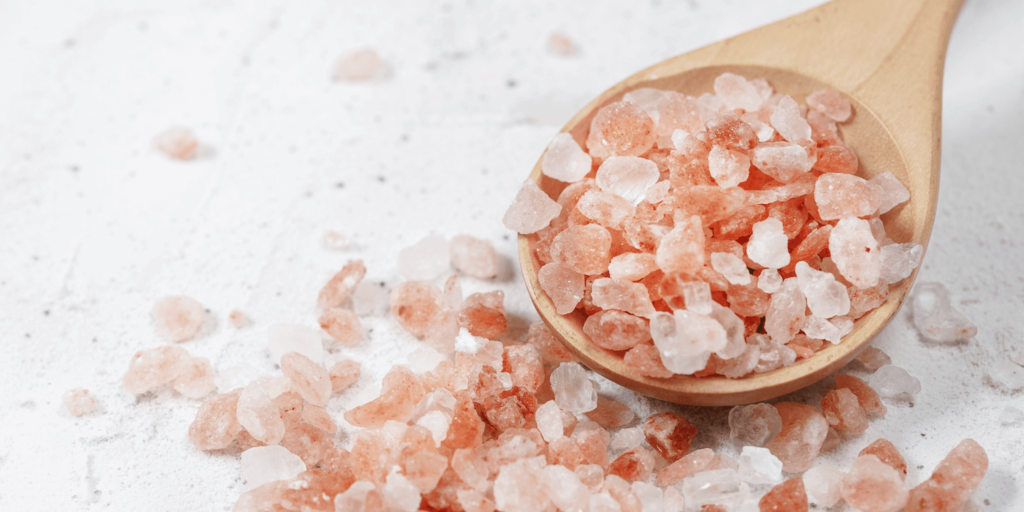
How Much Salt Is Too Much?
To be honest, this topic is of much contention. No one can really agree on how much salt is actually needed. The science is very skewed for pro-salt and anti-salt agendas.
Too little AND too much can do harm, but it all depends on your body.
We need at least 400 mg of sodium a day, especially when under stress or when exercising. We typically lose about a half teaspoon (about 2.5 mg) of salt per hour of exercise in our sweat. [18]
The United States Food & Drug Administration (FDA) recommends consuming less than 2,300 milligrams (mg) of sodium daily (which is about one teaspoon). We typically consume about 3,400 mg per day. Experts from the World Health Organization claim we should aim for under 2,000 mg of sodium per day.
Take all of this research with a grain of salt…. (pun intended)!
However, Japanese and South Koreans, on average, eat about 4000-5000 mg of salt per day, which is far higher than the World Health Organization’s recommendation. [19] About twice the limit. Yet they have some of the lowest rates of cardiovascular disease mortality. [20] Even the Mediterranean diet is high in salt. We don’t need to fear salt! Just eat real food.
In 2011, a study discovered that consuming less than 3 grams of sodium per day (equivalent to slightly over a teaspoon of salt) or more than 6-7 grams of sodium per day (equivalent to well over two teaspoons of salt) both increased the likelihood of experiencing a heart attack or stroke. [21, 22, 23]
If you have gastrointestinal issues (Celiac, IBS, parasitic infections, etc…), you’re likely not absorbing as much salt as you should be. Talk to your doctor.
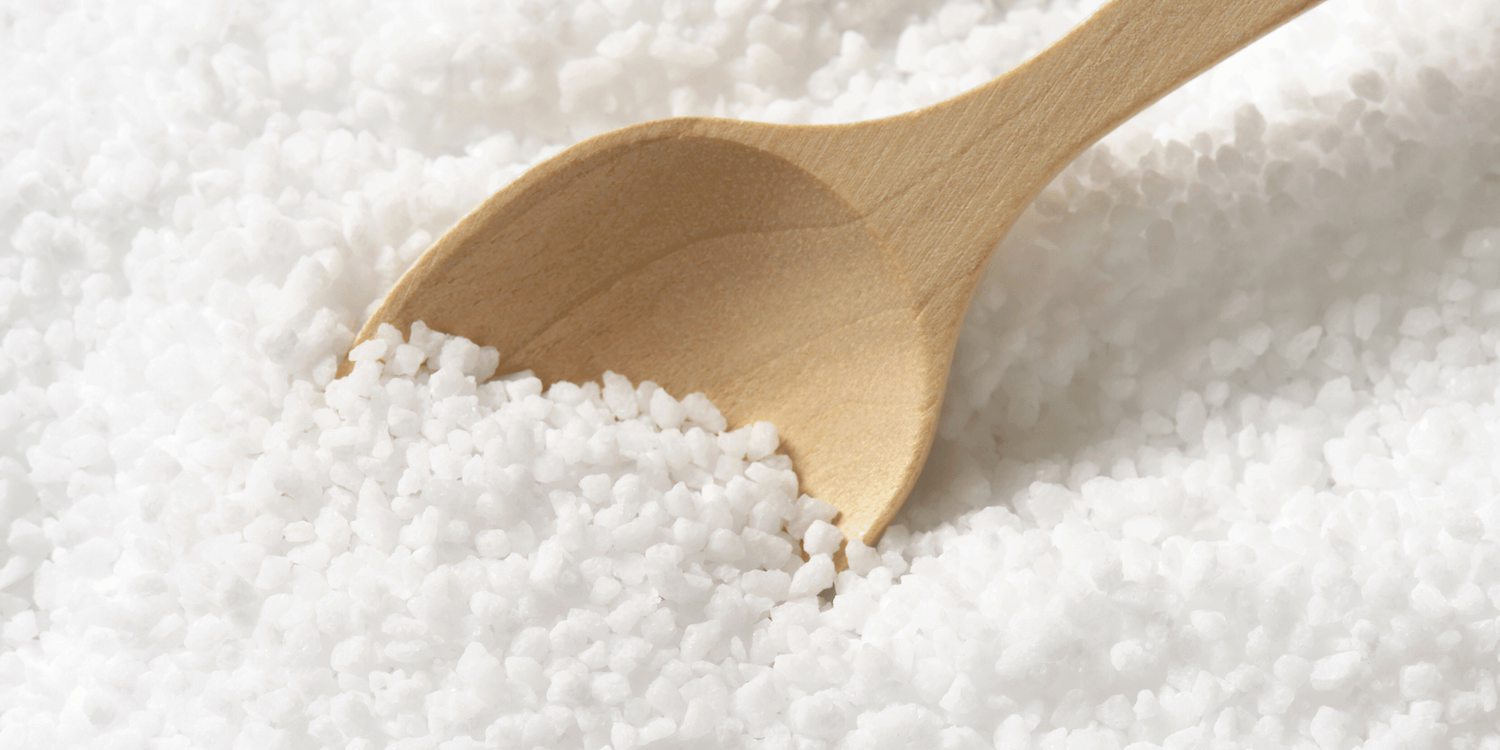
Are There Heavy Metals In Salt?
Yes, some types of salt may contain heavy metals such as lead, cadmium, and arsenic (which won’t be listed on the ingredient label). These heavy metals can come from natural sources in the environment or from human activities such as mining and industrial processes.
Overconsumption of heavy metals can cause adverse health effects, including damage to the kidneys, liver, and nervous system. Nonetheless, the levels of heavy metals in salt are typically low and are not a significant source of exposure for most individuals.
Some salt can have high levels of lead.
To lower the risk of heavy metal exposure from salt, individuals can choose high-quality salt that has undergone purity testing and avoid salt products sourced from areas with known pollution problems. Furthermore, having a varied and balanced diet can help reduce the likelihood of heavy metal exposure from any single food source.
While salt is typically used in small quantities, it’s important to remember that heavy metals, like lead, can have a cumulative impact on the body over time. This is why it’s important to be cognizant of the salt brand you’re using at home. It’s a simple swap that can help reduce your exposure!
Are There Additives In Salt?
Yes, some types of salt may contain additives. These additives can include anti-caking agents, which prevent the salt from clumping together, and iodine, which is added to some types of salt to prevent iodine deficiency.
Always read the ingredient list!
Anti-caking agents are often added to table salt to prevent it from sticking together in humid conditions. Some common anti-caking agents include calcium silicate, sodium ferrocyanide, and magnesium carbonate. Flavorings, colorants, and preservatives are also added to some salt brands.
Check Out The In On Around Shop
Are There Microplastics In Salt?
Microplastic contamination has become a growing concern!
Microplastics, which are small pieces of plastic less than 5 millimeters in size have been found in some types of salt such as sea salt and rock salt. These are tiny plastic pieces that are smaller than a grain of rice – most are invisible to the eye!
To minimize exposure to microplastics in salt, one can choose minimally processed salt or search for brands that have been tested and confirmed as microplastic-free. Furthermore, reducing plastic waste and pollution can help lower the occurrence of microplastics in our food and environment.
What To Look For In The Healthiest Salt Brands
When you’re shopping for salt, look for…
- Mineral-rich salt (contains trace minerals)
- Tested for heavy metals & impurities – ideally under 100 ppb of lead (which is 0.1 ppm)
- Ideally, the company should be transparent and release their Certificate of Analysis detailing heavy metal levels when requested
- Ask for their most recent test results. Sometimes companies will share older tests.
- In addition, many salts will contain a Proposition 65 warning since lead is a naturally occurring mineral. It’s always best to ask the company for their most recent Certificate of Analysis to review their lead levels.
- Extracted from high-quality ocean water
- If the ocean water used in salt production is contaminated with pollutants, such as heavy metals or chemicals, the resulting salt can also contain these impurities, making it unsafe for consumption.
- Free of additives (unless you need iodized salt)
- If you’re looking for salt with fortified iodine (not a great choice for everyone), opt for unrefined sea salt with added iodine.
Keep in mind, since we’re consuming salt in such low quantities, it’s intended to be for taste, NOT to add “nutrients to your meal… regardless of how “mineral-rich” the salt is. It only contains very small amounts of trace minerals. Most mineral consumption comes from food.
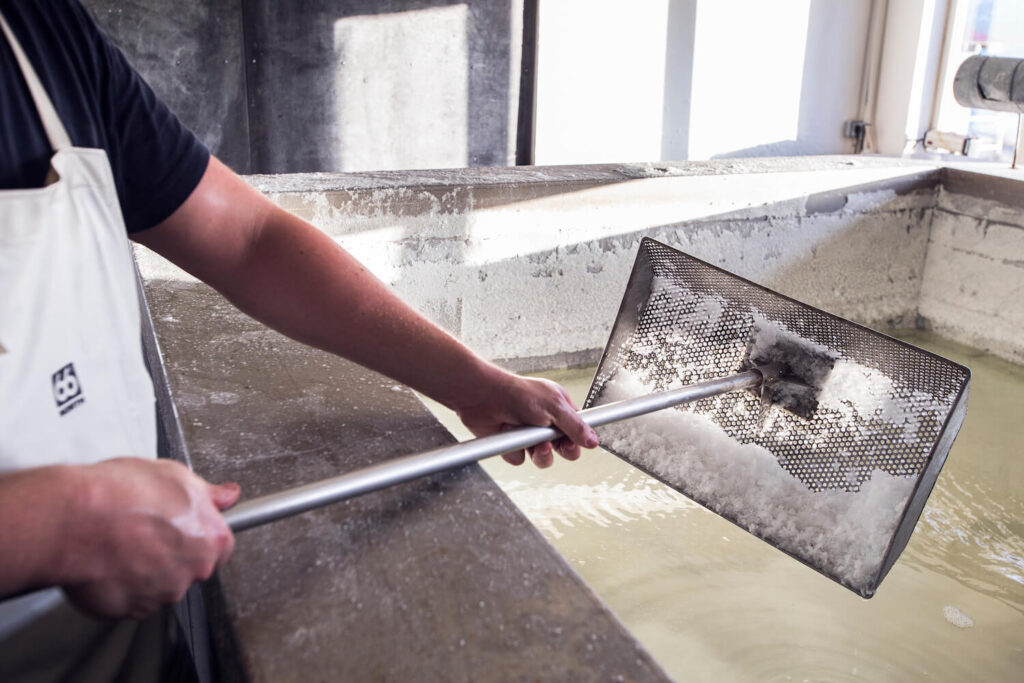
Best Salt Brands
Let’s dive into some of the best salt brands on the market…
1 – SaltWorks Premium Sea Salt (Pure Ocean Only)
SaltWorks initially sent me their NSF certification and Safety Data Sheet excerpt, but nothing detailed heavy metal levels of microplastic testing. When I dug in further, their Quality team sent me 3 Certificates of Analysis from January 2023 detailing heavy metal levels. Here’s what each said:
- Pure Ocean Premium Sea Salt contains about 40 ppb of Lead
- Ancient Ocean Himalayan Pink Salt contains under 500 ppb of Lead
- Pacific Blue Flake Sea Salt contains under 500 ppb of Lead
I love the test results for the Pure Ocean Sea Salt but would skip the others.
2 – Saltverk Icelandic Sea Salt
- Harvested from The Westfjords of Iceland
- Uses geothermal energy to boil the salt
- Water is naturally filtered through lava and rock
- Note: does not mention microplastics in any of their marketing material, but microplastics are found in lower quantities in the oceans around Iceland [27]
- Shared their 2016 3rd party test results with me and their salt contains under 30.1 ppb of lead. They don’t have a more recent test result, but their local health authority monitors sea water quality on an annual basis.
3 – Jacobsen Salt Company – Pure Flake
- Offers pure flake and kosher sea salt
- Tests for lead, microplastics, and potential radioactive isotopes
- Claims that lead levels are under 20 ppb for sea salt [26]
- Note – the 3rd party test results are not available on their website,
- While they wouldn’t send me a formal copy of their Certificate of Analysis, they said their Pure Flake and Kosher salts were tested in September of 2022 and came back under 20 ppb. Their Fine Italian Sea Salt contains 100 ppb.
- Harvested from the waters of Netarts Bay on the Oregon Coast
- Filtered via a reverse osmosis machine & added to boil tanks
- “The filtered sea water we use for our Oregon Salts is tested semi-annually by Polyhedron Laboratories. The last test was performed on June 1st, 2021, and no microplastics were detected. All of our incoming sea water is filtered through a 0.5 micron filter.”
- Their Himalayan salt contains up to 0.50 ppm (or 500 ppb) – LIMIT use of the Himalayan salt
4 – Selina Naturally Celtic Sea Salt – Makai Pure Only
- Additive-free (no iodine added)
- Fine Ground Celtic® are from France, while the Celtic Kosher™ Coarse and Fine are from Colima, Mexico. [28]
- According to their website, “no microplastics were discovered in Makai Pure or Fine Ground Celtic.”
- Contains the brine, so may come wet
- They occasionally do 3rd party testing for impurities
- Their website provides Certificates of Analysis (not the originals) that show lead levels of 0.000041% (410 ppb) in Light Grey Celtic Sea Salt and 0.000065% (650 ppb) in the Fine Ground Sea Salt. Lead levels were lowest with their Makai Pure line at 50 ppb of lead.
- Since these aren’t official untouched 3rd party test results, take it with a grain of salt.

5 – Redmond Real Salt
This is a “better” option if you’re looking for a pink salt – it’s certainly not the “best.”
- Harvested from Redmond, Utah as unrefined, ancient sea salt.
- Redmond has received some backlash over the past couple of years due to Lead Safe Mama’s review, claiming the salt contains 167 ppb of lead. [29, 30] Some people claim that have deceptive marketing practices – I’ll leave that up to you to decide.
- The brand puts mineral analysis and Material Safety Data Sheet information on their website, but these are not direct 3rd party test results. [31] Their customer service team couldn’t provide a COA for a specific batch, however cumulatively it’s contains about 0.000020% of lead (~200 ppb) in the final product. The table below is a culmination of multiple undisclosed third party test results.
- Personally, they’re not my first choice by any means, but I would be open to using them occasionally if I needed pink salt.
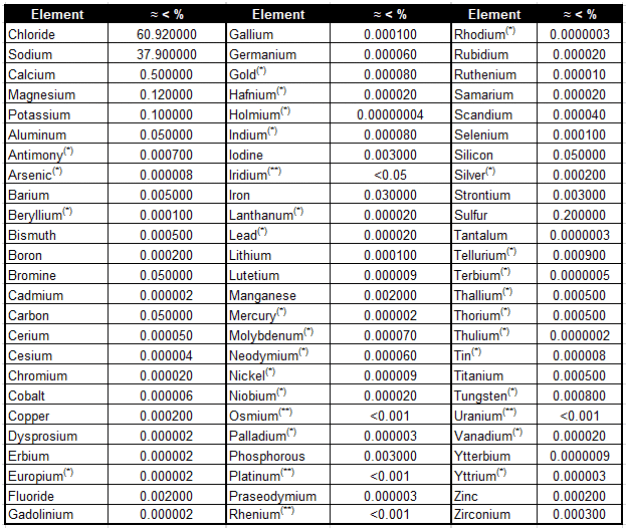
Lastly, if you’re looking for drinkable salt packets, check out LMNT Electrolyte Salt Packets. These have about 1000 mg of sodium, 200 mg of potassium, and 60 mg of magnesium!
| Note: This is a non-exhaustive list. Ask every brand for full Certificate of Analysis (COA) results to understand lead levels. A full COA will detail heavy metal levels in either part per million (ppm) or part per billion (ppb). |
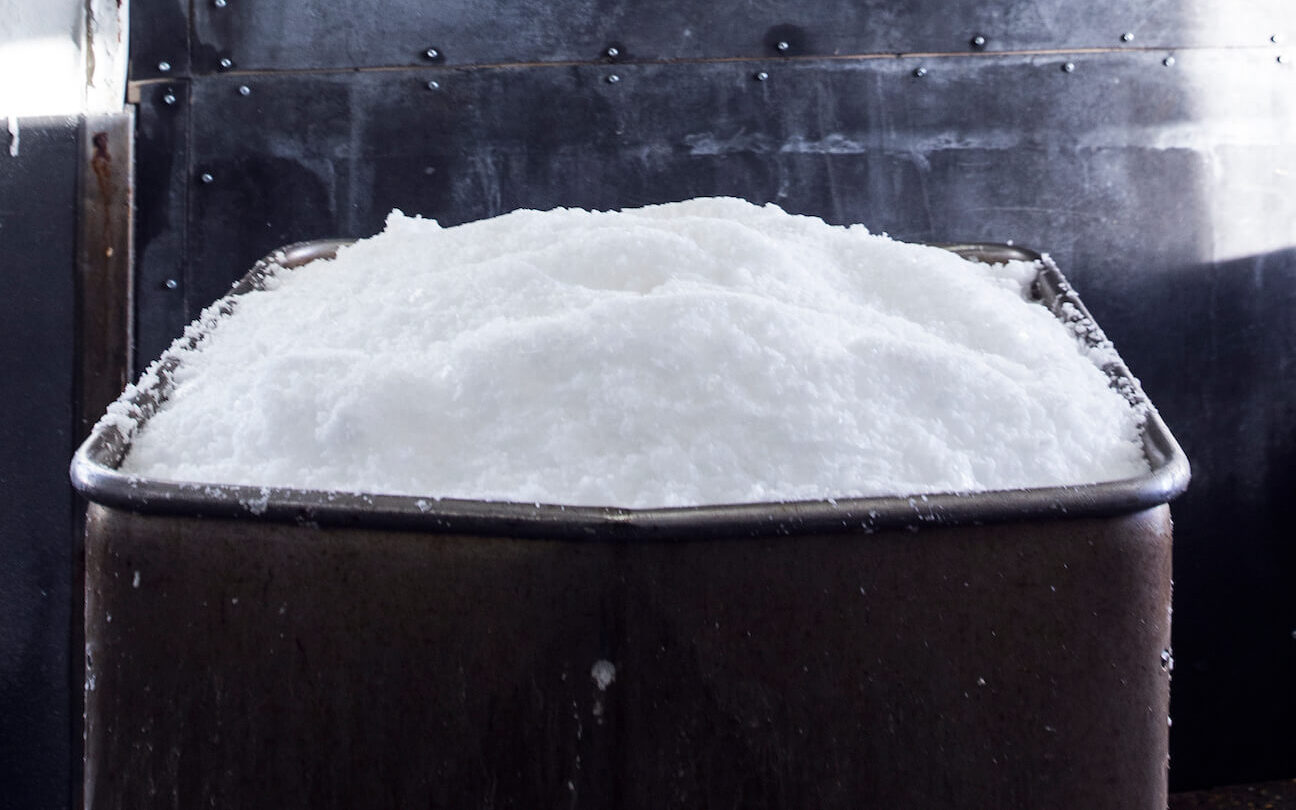
Final Thoughts – Healthiest Salt Brands
Do I stress about the type of salt I’m consuming? No, absolutely not. Any potential contaminants are in such a very small amount, BUT I do prefer using higher-quality salt at home, when possible.
I love incorporating salt into my home-cooked meals… and since I’m focusing on real food, I don’t fear it. Neither should you. You certainly won’t find me on a “low-sodium” diet, which can do just as much harm.
If you’re concerned about your salt intake, focus more on eating real, whole foods instead of processed foods. This doesn’t mean eating as much salty food as you want – too much salt can do harm. But it’s essential to remember that too little salt can be equally as harmful, if not more. There’s no need to be afraid of salt. Moderation is key!
If you’re interested in learning more about salt, check out James J. DiNicolantonio’s book, The Salt Fix.
⬇ Pin this “Heavy Metals In Salt?” pic on Pinterest for future reference! ⬇
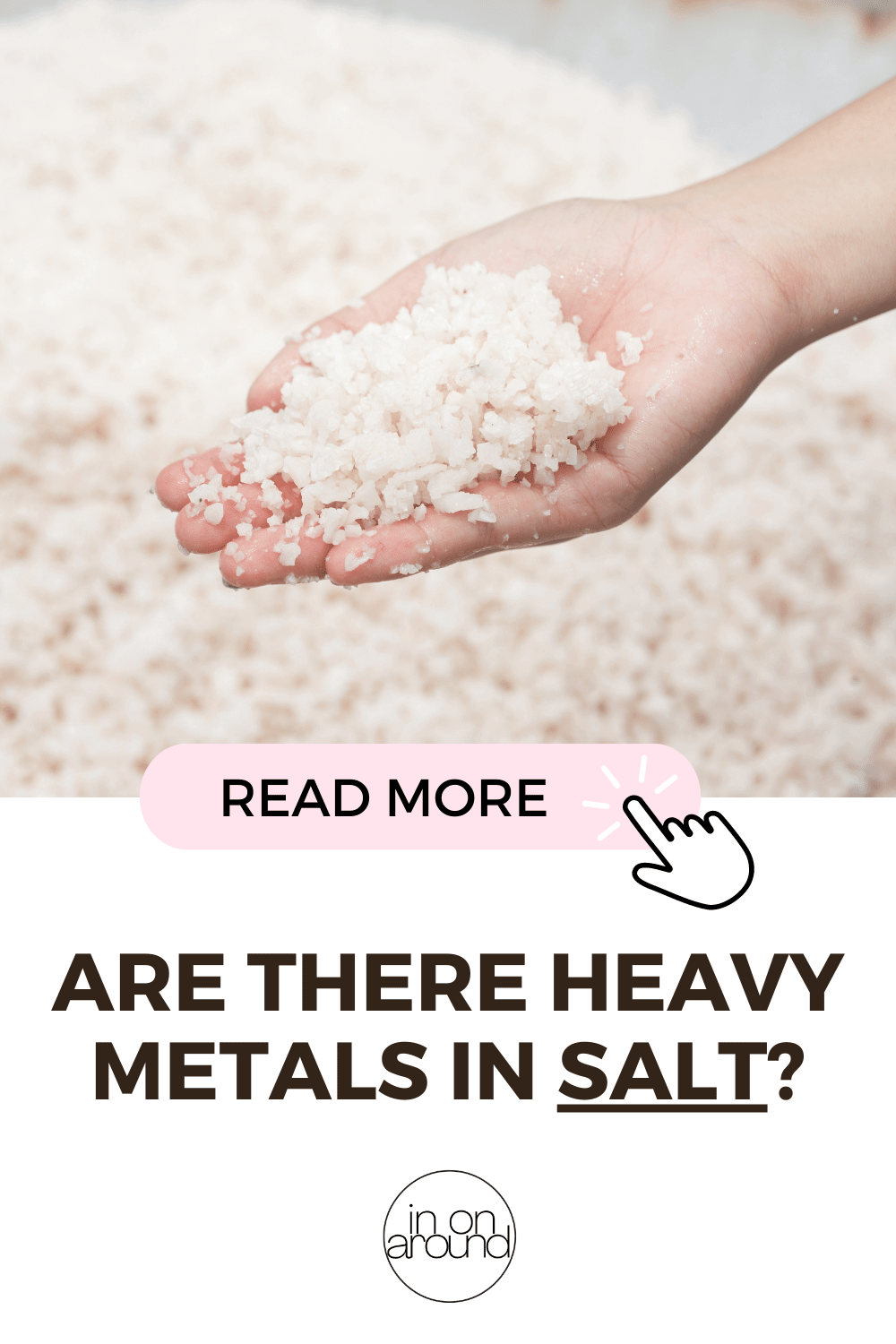
Frequently Asked Questions – Minerals In Salt
Click on the below FAQs to learn more about salt, sodium, mineral deficiency, trace minerals, halite, and more.
Does salt go bad?
What are the long-term health effects of consuming too much salt?
Is sea salt healthier than table salt?
Is a low-salt diet dangerous?
What Did You Learn?
Let me know your thoughts and key takeaways in the comments below!
You can watch our web story here.
xoxo,

Want to read more? Check out my other articles here!
Other references on Minerals In Salt: Lead Safe Mama, Green Queen, Dave Asprey, Riordan Clinic, Scientific American, American Heart Association, Health First Network, Lyn Alden, Dr. Axe, I Read Labels For You, Clean Green Toxicant Free, Mark’s Daily Apple, Bulletproof, Dr. Will Cole, Dr. Hyman, Medium, Health, Roots and Boots, Purely Planted, LA Times, NIH, WHO
Copyright In On Around LLC 2023 ©. The statements made on this website have not been evaluated by the FDA (U.S. Food & Drug Administration). They are not intended to diagnose, treat, cure, or prevent any disease. The information provided by this website should not be used as individual medical advice and you should always consult your doctor for individual recommendations and treatment. The information contained in this site is provided on an “as is” basis. Related to this site, there are no guarantees of completeness, accuracy, usefulness, or timeliness. In On Around LLC assumes no responsibility or liability for any errors or omissions in the content of this site.

